Hello, true believers, and welcome to Tom’s shameless name-dropping Pinball Expo article! Mike and I (along with our entourage) attended the Expo this past weekend and were witness to the majesty and wonder of the world and history of all things pinball! And, y’know, since we (and this is not a big deal) work for a pinball company, we had a jolly good time. Plunge the ball to begin your game!
The Expo took place this last weekend, October 19 through the 23rd at the Westin Chicago North Shore Hotel in Wheeling, IL. We attended Friday night and Saturday afternoon, and were pleased with the turn out. All manner of gamers, enthusiasts, aficionados, connoisseurs, geeks, nerds, and (believe it or not) groupies were in attendance. The main lobby was sprinkled with a taste of pinball, from some of Stern’s newer offerings (like Transformers and Rolling Stones) to some classics of all makes and models throughout the years. These machines were set up for their main contest, which I did not enter because I suck at pinball. Ah, irony.

Stern's newest offering: a pinball machine based on all three of the recent Transformers movies. Explosions sold separately.
One of my favorite machines, titled “Hercules”, was on display in the main hallway. Wanna know why it’s called Hercules? I direct your attention to the photo below. This is the biggest freakin’ pinball machine I’ve ever seen. How big..?
The party was fun. Other pinball greats were there, including famed Designer Steve Ritchie (who also did the original narration for the first two Mortal Kombat games) and Designer John Borg. In case you’re wondering, we totally know both of them. I’m not one to name-drop, but yeah. It’s actually a little tacky that you brought it up, but what’s said is said. Anyway, we were itching to play some pinball, so it was off to the main game room!
Many of the Expo’s oldest games were in the front, and it was a hoot to see and play them! The older machines were much more basic, with pop bumpers being the major mechanical element of the playfield. Somehow their simplicity made them more difficult to play than the newer games. Or maybe I just suck. I prefer the former, but must assume the latter.
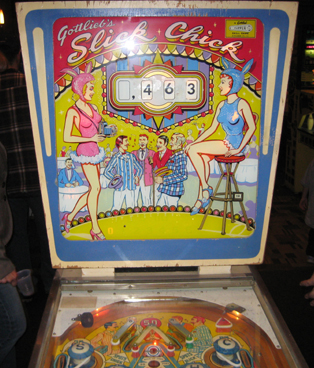
There's nothing more manly than playing a few rounds of Slick Chick. It's enough to get you into a terrible Miller Light commercial.
One of the coolest things about playing these old games is that it really gave you an appreciation for how far pinball machines have come. Seeing the score count up on a mechanical, number-flipping score-counter really puts it into perspective–we’re a long way from dot matrix boards and animatronics, to be sure. It was also a window into another time–most of the subject matter and imagery centered around Archie-like teenagers socializing and the majesty of space travel; pretty indicative of the 50s and 60s. Another blast from the past was seeing three one-of-a-kind pinball machines built specifically for the 1979 film “Tilt”, starring a young Brooke Shields pwning noobs in pinball. This was their first public showing in over 30 years!
Not all the show’s displays were regular pinball machines, either. One game, titled “Crazy”, was a “vertical” take on the classic machine, where you use flippers to knock a ball up a series of ramps, eventually reaching the very top of the case to score your points.
Another was a baseball-inspired game, creatively titled “2-Player Target Gallery”, where you pitch yourself a ball and knock it across the board into targets of Tom & Jerry-copyright-infringing cats and mice. A very fun game, and if I’m not mistaken, the very same kind of machine found in an episode of American Pickers.
Old games are fun, but there comes a time when you need corny toys, monochromatic animation and loud, annoying noises. On to the newer games! Further along in the showroom, and mostly in the secondary play room, were all manner of machines, spanning the 70s, 80 and 90s. The ones from the 70s were fun, but much simpler–mostly psychedelic imagery and simple mechanics. It was in the 80s and 90s that pinball blossomed and evolved into the modern incarnation we’re all familiar with today. They had original classics such as Medieval Madness, Attack From Mars and Airborne, and licensed legends like the original Simpsons machine, Addams Family and Monopoly.
The fun thing about pinball machines is that they’re all unique. The playfield of a game called “Black Hole” housed a second, reversed playfield underneath a pane of glass. The ball drops in and you have to play backwards until it drains up and pops back onto the top layer. Another game, titled “Fire!”, was so difficult my first game on it probably lasted one minute. You learn quickly playing so many machines that being good at one doesn’t mean you’ll be good at another, and some switch up the play style so much they become something new. I had a fondness for a game called Hyperball, designed by none other than Steve Ritchie (that guy I mentioned before that I know. No big deal.). In it, you fire a seemingly never-ending stream of pinballs at alphabetized holes, trying to spell words. Whether you succeed in spelling them or not was inconsequential to me–it was just so much damn fun firing off pinballs like a machine gun!
Unfortunately, the game only worked about half the time, because of a ball jam in one of the ramps underneath. But that didn’t stop me from playing it all day and driving my friends crazy.
It was also fun to see masters at work. Many of the attendees were seasoned pinball players, easily racking up ridiculous scores. Lyman Sheats, programmer for Stern, was there, doing what he does best. And when I say best, I mean it: Lyman runs the competitive circuit, and at one time he was the best pinball player in the world. Yeah. It’s kind of a big deal. In his tenure at Stern, he’s helped create such games as Spider-Man, Tommy (The Who) and The Dark Knight, to name a few. And we totally know him, by the way.
And just in case you thought this has nothing to do with Sega, they had several of Sega’s own pinball machines on display! Mary Shelley’s Frankenstein, based on the ill-received Robert DeNiro film from the mid-90s, provided some spooky fun. And another 90s movie, Apollo 13, got the Sega treatment courtesy of designer and all around swell guy John Borg. He was gracious enough to pose with me in front of his mechanical baby.
And if all the free pinball you can stomach wasn’t enough for you, they also had an extensive vendor area, where all manner of pinball parts and accessories were on display. Now, only two companies currently produce pinball games: Stern Pinball, Inc., and Jersey Jack Pinball, so most of the vendors were appealing to the collector and customizer, who have now become the major patrons behind the industry. Many of the vendors sold replacement parts (both new and old), customized decorations, customizable LEDs, custom legs and custom-made graphics. My personal favorite items were the black chrome pinballs. Now all I need is five grand to buy a pinball machine. And the fun wasn’t limited to pinball–other companies had slot machines on display.
So, what more can be said? Pinball Expo 2011 was quite an experience, and nothing brings out your inner child like beating the holy hell out of a small, chrome ball with flippers. All the fun we had is a testament to all the hard work that so many people put into these playable works of art. There’s a good reason pinball is becoming popular again–these things are awesome!
Now, how can I punctuate this article? I’ve run out of names to drop, and I need something intellectual and endearing to close it with…
Perfect! See you next year!


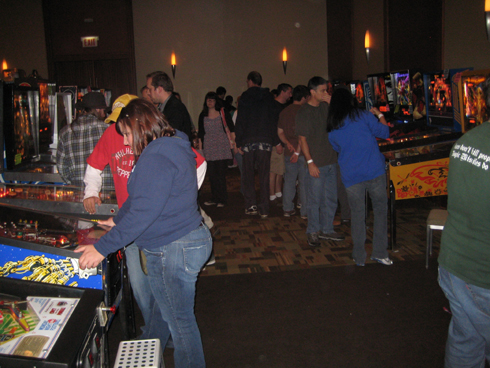

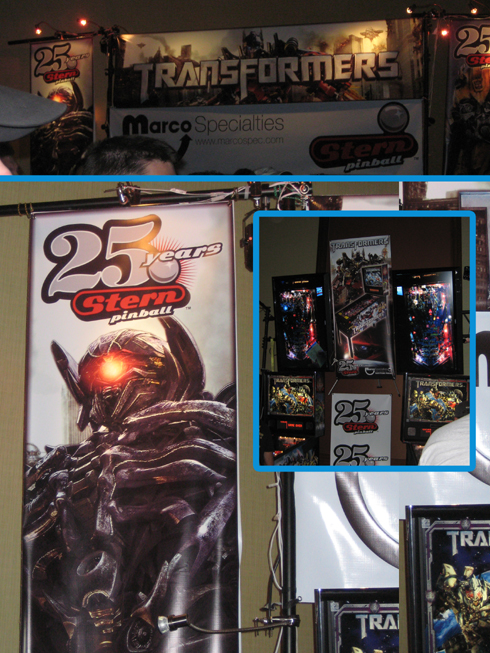

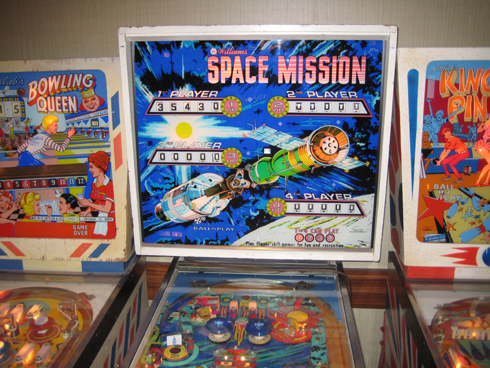
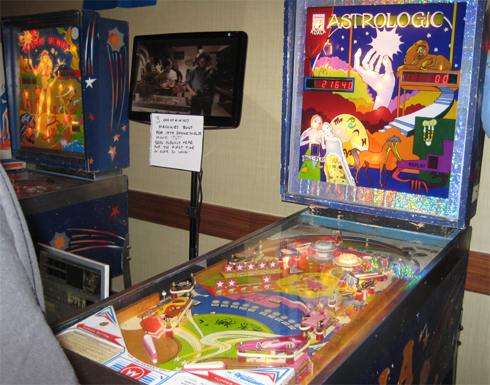
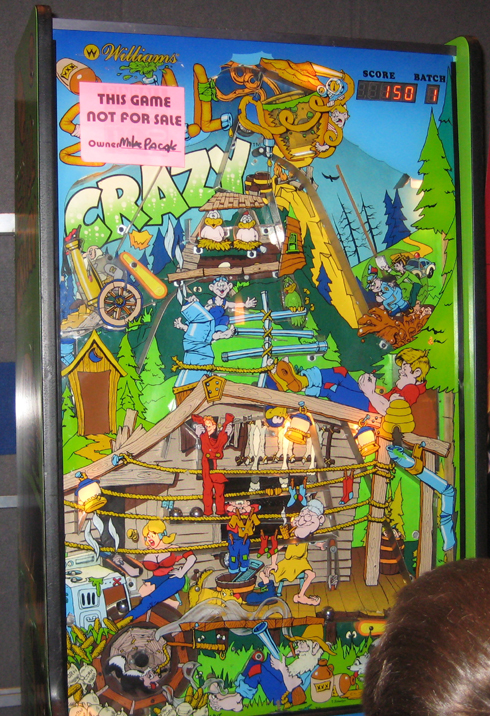
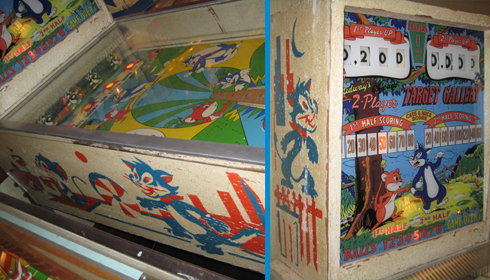
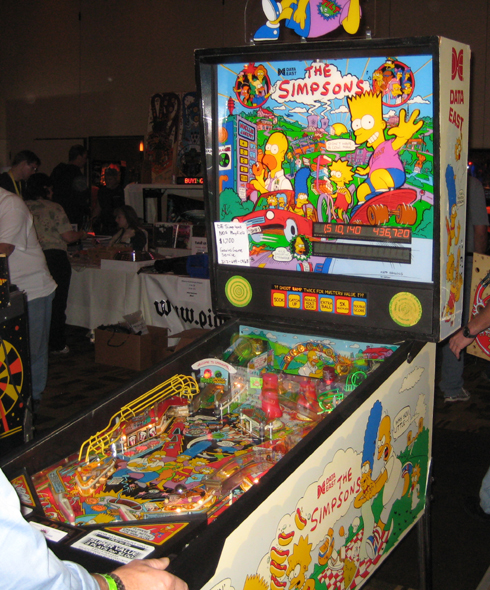


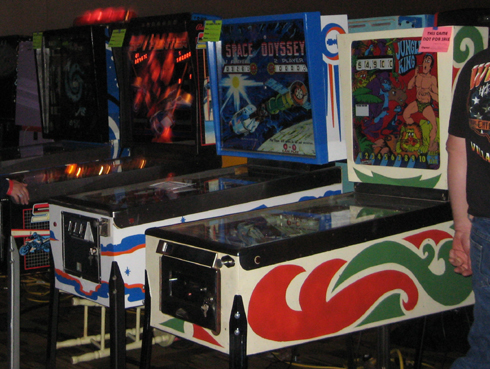
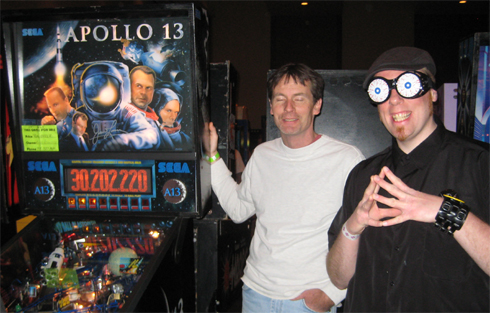
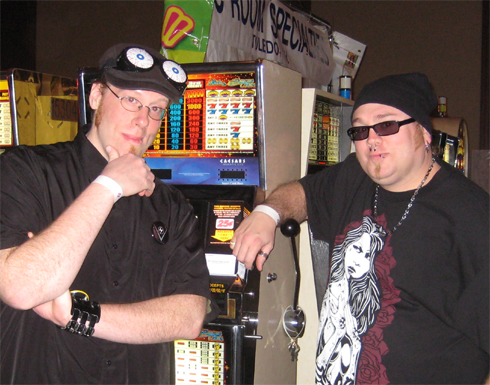
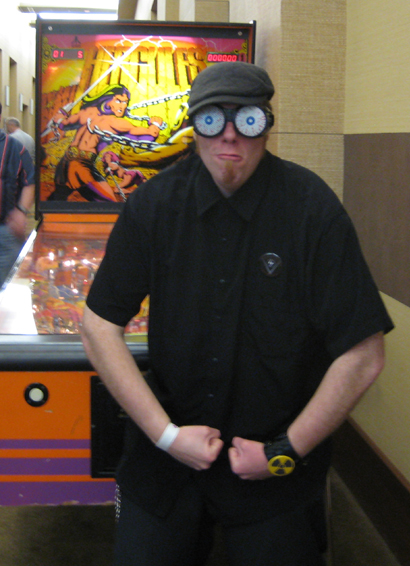

Wow so jealous, this looks like a ton of fun.